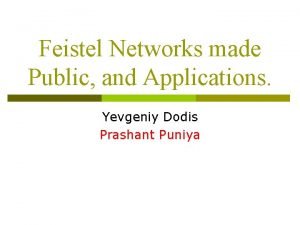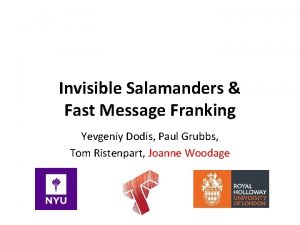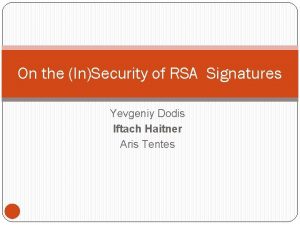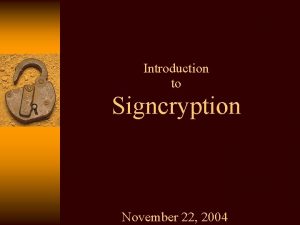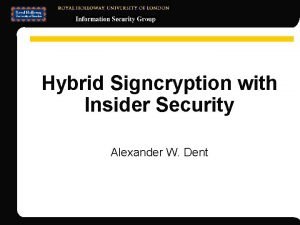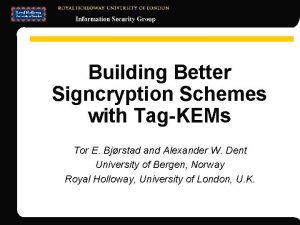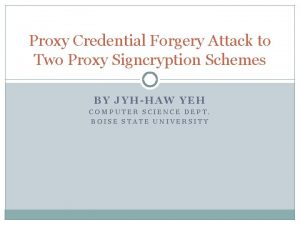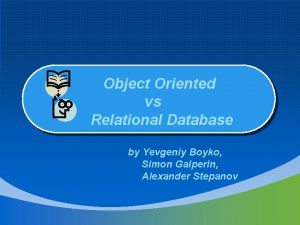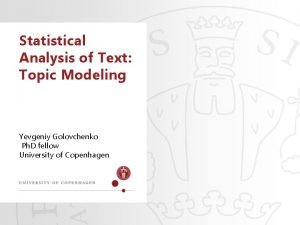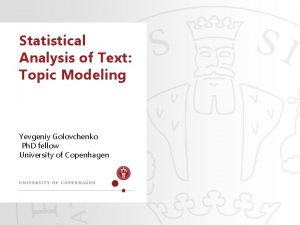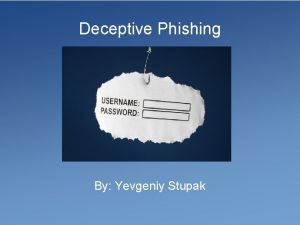Signcryption what why and how Yevgeniy Dodis New




![Prior Work • Initial study of signcryption [Zheng 97, …] – Main motivation efficiency Prior Work • Initial study of signcryption [Zheng 97, …] – Main motivation efficiency](https://slidetodoc.com/presentation_image_h2/81f7999fa7b5599176502cb136b5b68f/image-5.jpg)
![Our Results I [ADR 02] • Formal definition(s) of signcryption – Multi-user vs. Two-user Our Results I [ADR 02] • Formal definition(s) of signcryption – Multi-user vs. Two-user](https://slidetodoc.com/presentation_image_h2/81f7999fa7b5599176502cb136b5b68f/image-6.jpg)
![Our Results II [DFW 03] • More efficient parallel signcryption: Padding-based Parallel Signcryption (Pb. Our Results II [DFW 03] • More efficient parallel signcryption: Padding-based Parallel Signcryption (Pb.](https://slidetodoc.com/presentation_image_h2/81f7999fa7b5599176502cb136b5b68f/image-7.jpg)
![Our Results III [DA 03] • General way to build signcryption on long messages Our Results III [DA 03] • General way to build signcryption on long messages](https://slidetodoc.com/presentation_image_h2/81f7999fa7b5599176502cb136b5b68f/image-8.jpg)
































- Slides: 40

Signcryption: what, why and how Yevgeniy Dodis New York University

Signature and Encryption • Most basic cryptographic tools • Signature: – Receiver is sure message came from sender – Provides Authentication • Encryption: – Only receiver can understand the message – Provides Privacy

Common Design Wisdom • Never mix things together • Make the design as modular as possible – Have freedom to design independent privacy and authentication components • When both are needed, combine known solutions – Encrypt-then-sign (Et. S): Sig(Enc(m)) – Sign-then-encrypt (St. E): Enc(Sig(m)) • But given both are needed so often, shall we define/design tailored solutions? Signcryption? ? ?

YES Signcryption as a Primitive? • Are we sure Et. S and St. E are “secure”? – NO, if we are not careful ! (yes, if we are) • Do we know exactly what we mean by “private authenticated communication”? – Definition is non-trivial ! • Maybe we can build significantly more efficient/secure solutions than Et. S/St. E? • Maybe we can in fact simplify protocol design by having this high-level primitive?
![Prior Work Initial study of signcryption Zheng 97 Main motivation efficiency Prior Work • Initial study of signcryption [Zheng 97, …] – Main motivation efficiency](https://slidetodoc.com/presentation_image_h2/81f7999fa7b5599176502cb136b5b68f/image-5.jpg)
Prior Work • Initial study of signcryption [Zheng 97, …] – Main motivation efficiency – Security arguments: no formal definitions/proofs • Using authentication to go CPA->CCA – El. Gamal Encryption [TY 98, SJ 00] – Symmetric setting [BN 00, K 01, BR 00] • Authenticated Encryption (symmetric setting) – Definitions [KY 00, BN 00, BR 00] – Sequential Composition Et. A/At. E [BN 00, K 01] Called “good” if MAC helps CPA->CCA (justified but unnatural) – Encrypt/encipher-with-redundancy [AB 01, BR 00] – New Block Cipher Modes (RFC, IAPM, OCB, SNCBC, …)
![Our Results I ADR 02 Formal definitions of signcryption Multiuser vs Twouser Our Results I [ADR 02] • Formal definition(s) of signcryption – Multi-user vs. Two-user](https://slidetodoc.com/presentation_image_h2/81f7999fa7b5599176502cb136b5b68f/image-6.jpg)
Our Results I [ADR 02] • Formal definition(s) of signcryption – Multi-user vs. Two-user setting – “Insider” vs. “Outsider” distinction • Et. S/St. E are secure if modeled properly… • Paradigm of parallel signcryption: – Performs expensive Enc and Sig in parallel – Commit-then-Encrypt-and-Sign (Ct. S&E) – Leads to fast On-line/Off-line Signcryption • Definitional inadequacy of CCA security
![Our Results II DFW 03 More efficient parallel signcryption Paddingbased Parallel Signcryption Pb Our Results II [DFW 03] • More efficient parallel signcryption: Padding-based Parallel Signcryption (Pb.](https://slidetodoc.com/presentation_image_h2/81f7999fa7b5599176502cb136b5b68f/image-7.jpg)
Our Results II [DFW 03] • More efficient parallel signcryption: Padding-based Parallel Signcryption (Pb. PS) – Fully compatible with PKCS#1 standard • • Works with PSS-R, OAEP+ & other paddings Based on any TDP f (e. g. , RSA) Simple and flexible key management Same f can be used to both send & receive data… – Effortlessly supports associated data – Tight exact security and many more… • New notion: universal two-padding schemes – New padding: PSEP, hybrid of PSS-R & OAEP
![Our Results III DA 03 General way to build signcryption on long messages Our Results III [DA 03] • General way to build signcryption on long messages](https://slidetodoc.com/presentation_image_h2/81f7999fa7b5599176502cb136b5b68f/image-8.jpg)
Our Results III [DA 03] • General way to build signcryption on long messages from that on short messages – Very simple and efficient – Couple with Pb. PS very practical signcryption ! • Utilizes a new primitive of independent interest: Concealment • Strong version equivalent to CRHFs, weak version can be built from UOWHFs (and, thus, OWFs) • Remotely Keyed (Authenticated) Encryption – Formal definition and simple solution – Considerably simplifies/generalizes prior work

Defining Signcryption Ideal Functionality: Love from Alice ? Implementation: • Each player P publishes key pair (Sec. P, Pub. P) • To send m from sender S to receiver R – u = Sig. Enc(m; Sec. S, Pub. R); m = Ver. Dec(u; Pub. S, Sec. R)

Example: Et. S Love from Alice ? Alice But what if intervenes?

Example: Et. S (cont) ? Alice Love from Ugly Moral Need to use identities from Alice? ? ? in multi-user setting! Both for syntax and constructions

Formal Definition (multi-user) • When attacking U, adversary A(Pub. U) can: – Ask Sig. Enc(m; Sec. U, Pub. R), for any receiver R – Ask Dec. Ver(m; Pub. S, Sec. U), for any sender S • To break authenticity, outputs new forgery: – (m; Sec. R) s. t. Dec. Ver(m; Pub. U, Sec. R) – Note, allow A to choose receiver R ! • To break privacy, guesses b w/pr. > ½: – Chooses (m 0, m 1, Sec. S), for S of A’s choice ! – m* Sig. Enc(mb; Sec. S, Pub. U), for random b

Two- vs. Multi-User Setting • Can formally define both settings – Two-user is much simpler: no IDs ! • Only sender S and receiver R • Shows no attacks on the scheme, only on IDs – But multi-user needed in applications… • “Multi-User = Two-User + ID fraud protection” • For all our schemes, some natural “tricks” always work to go two-user multi-user – First describe two-user version – Then show to get multi-user

Parallel Signcryption • Apply expensive “encrypting” and “singing” on in parallel • New alternative to sequential composition • Can offer other advantages beside parallelism and efficiency – – More flexible key management Easier for tight security reductions On-line/Off-line Signcryption Aesthetics: more elegant

Generic Parallel Signcryption St. E m Et. S Ct. E&S m s = Sig. S(m) ψ = Enc. R(m) m d c u = Enc. R(s) u = Sig. S(ψ) ψ = Enc. R(d) s = Sig. S(c) s = Dec. R(u) ψ = Ver. S(u) d = Dec. R(ψ) c = Ver. S(s) m = Dec. R(ψ) m What properties on (c, d) are needed for Ct. E&S?

Properties of c and d Recall, Signcrypt(m) = (Sig(c), Enc(d)) 1. [m (c, d) m] should be fast 2. Privacy: c should not reveal “any information” about m “hiding” – Indeed, c goes “in the clear” – If find d’ such that (c, d’) is valid and d’ d, then (Sig(c), Enc(d’)) is a new forgery 3. Authenticity: should be hard to “reuse” “binding” Sig(c) COMMITMENT SCHEME!!! (“relaxed” commitment scheme is necessary and sufficient… see paper)

Improving Generic Approach • Need IND-CCA Enc and s. UF-CMA Sig – Expensive • What if implement in RO model? – Say, PSS for Sig, OAEP/OAEP+ for Enc… • Wasteful, need to “pad” twice ! – – – Poor exact security Poor message bandwidth Less efficient Need to store two independent keys Aesthetics: inelegant • Can we do (much) better? YES!

Padding-based Parallel Signcryption Ct. E&S Pb. PS m m Commit “Two-Pad” d c Enc. R Sig. S ψ σ w s ψ σ

Advantages of Pb. PS • Replace expensive Enc and Sig by a TDP f and -1 its inverse f (e. g. , RSA) • Can reuse f for sending and receiving – Entire Pub. U = f, Sec. U = f-1 • Consistent with current PKI infrastructure suggested by PKCS#1 • Better exact security • More efficient if “two-paddings” are fast • What are these “two-paddings”? ? ?

Universal Two-Paddings • Invertible Pad(m) (w, s) s. t. for any TDP f – [f(w), s] is IND-CCA-secure encryption – [w, f– 1(s)] is s. UF-CMA-secure signature – In fact, holds even if reuse the same f for both signature and encryption • Lemma: if Pad is universal two-padding, – 1 then [f. R(w), f. S (s)] is a secure signcryption in the two-user setting – Later extend to multi-user setting

Two-Padding Results • Note: must use Random Oracle Model as use TDPs • Give a wide variety of universal two-paddings: – Old: PSS-R, OAEP+, SAP (“scramble all padding”) – New: many, most notably PSEP (mix of PSS-R & OAEP) • All are special cases of one general construction! – In particular, found generalization of most padding schemes commonly used for plain signature/encryption

Intuition Behind Construction • Most known padding schemes already naturally consist of two pieces (w, s) • Moreover, always have (w, s) = Feistel(d, c) for some pair (d, c). • Example: PSS-R d c H w s – Have w = G(m, r), s = H(w) (m, r). – Can write w = c, s = H(c) d, where c = G(m, r), d = (m, r) • What properties on (d, c) suffice? ?

Extractable Commitment Given by two properties: 1. (Strong) Hiding: c(m) looks random, for any m - usually holds anyway for any natural commitment 2. Extractability: using some “trapdoor” T, can find d from c. - • There is Extract(c, T) d procedure s. t. for any A: Pr[ (c, d) valid & Extract(c, T) d | (c, d) A ] = negl. In the RO model, trapdoor T = RO queries made by A Note: extractability implies strong binding – Hard to find (c, d, d’) s. t. (c, d), (c, d’) are valid and d d’

Feistel Two-Paddings • Theorem: If Commit(m) (c, d) is an extractable commitment then Pad(m) = (w = c, s = H(c) d) is a universal two-padding scheme • Note: we will see that all natural commitments in the RO model are anyway extractable • Thus, essentially show that applying one round of Feistel to a pair (c, d) good for Ct. E&S, get a twopadding (w, s) good Pb. PS ! – Feistel allows to replace expensive Enc and Sig by a TDP f and its inverse f-1 (e. g. , RSA)

Examples • • • If c = G(m, r), d = (m, r) get PSS-R If c = G(r) (m, 0 k), d = r get OAEP If c = (G(r) m, G’(m, r)), d = r get OAEP+ If c = G(d) m 2, d = (m 1, r, G’(m 2)) get SAP Probabilistic Signature Encryption Padding (PSEP): arbitrarily split m = m 1||m 2 and set c = (G(r) m 1, G’(m 2, r)), d = (m 2, r) – if |m 1|=0 get PSS-R, if |m 2|=0 get OAEP – but now can achieve much higher bandwidth ! E. g. , with 1024 -bit keys can fit 1600 bits of m

Associated Data Support • Associated data binds a public label L to m – L is transmitted in the clear, together with “actual” signcryption of m – Still, authentication applies to both L and m – Very useful in many contexts [Rogaway 02] • All our constructs easily support arbitrarily long associated data at nearly no cost ! – Simply stick L into H during the Feistel round • Simple two-user multi-user conversion – Add public keys of S and R as part of the label

Full Pb. PS scheme: 1. short messages 2. long labels m L IDR IDS Commit d c H w s ψ σ L

Signcrypting Long Messages • Main Question: given good signcryption SC on short messages m, how to signcryption arbitrarily long messages M? • Approach: transform M (b, h) and set SC*(M) = (SC(b), h) – (note: want to have |b| << |M| ) • Sub-Question: what transformations T are needed to make SC* secure? • Answer: concealments !

Concealments Recall, SC*(M) = (SC(b), h) 1. |b| < |M| (non-triviality) 2. Privacy: h should reveal “no information” about M “hiding” – Indeed, h goes “in the clear” – If find h’ such that (b, h’) is valid and h’ h’, then (SC(b), h’) is a new forgery 3. Authenticity: should be hard to “binding” “reuse” SC(b) COMMITMENT SCHEME!!! CONCEALMENT (“relaxed” concealment scheme is necessary and sufficient… see paper)

Commitment vs. Concealment • commitment c & decommitment d • hider h & binder b • both hiding and binding is on c • hiding on h & binding on b • always imply OWFs • useful even when |c|>|m| (i. t. binding) • trivial if |b|=|M| • otherwise imply CRHFs • (Sig(c), Enc(d)) • (h, Signcrypt(b))

Constructing Concealments • Use one-time symmetric encryption (E, D) • Set h= Eτ(M), b = (τ, K(h)), where K is CRHF – Hiding is obvious, binding is due to CRHF K – Notice, b is indeed short • If SC supports (long) associated data, can set h = Eτ(M), b = τ and L = h (+extra label) – Binding since pair (b = τ, L = Eτ(M)) commits M – Nicely applies to Pb. PS • Here is the final multi-user signcryption of long messages with associated data

Full-fledged Pb. PS scheme: M τ Eτ Commit d L IDR IDS π L c H w s ψ σ

Conclusions • Formally defined signcryption – importance of IDs, multi-user security, … • Parallel Signcryption & its advantages – generic Ct. S&E paradigm – big improvement: Pb. PS • Two-padding schemes – general Feistel construction from commitments – get many old padding (PSS-R, OAEP, …) + new (PSEP) • Concealment Primitive: define, construct + apps • Full-fledged signcryption of long messages – flexibility, efficiency, simplicity, generality, security – consistent with existent standards/PKI

Thank you ? end Alice





ZSCR Standard Assumption? TBOS St. E/Et. S Ct. E&S This Work No Yes Yes Poor Very poor Good Excellent No No Yes Yes Multi-User Setting? Yes No Yes Yes CCA 2 Security? Yes Yes/No No Yes Strong Unforgeability No No No/Yes No Yes General Construction? No No Yes Yes Key Flexibility? No No Yes Yes No No No Yes Avoid Special Set-up? No Yes Yes Extract Plain Sig/Enc? No Only Sig/Enc Yes Associated Data? No No Yes Compatible to PKCS#1? No Maybe Yes Parallel Operations? n/a No No Yes Exact Security? Insider Security? Key Reuse (Short Key)?

ZSCR TBOS St. E/Et. S Ct. E&S This Work 4096 Expect > 1350 bits Expect > 700 bits Expect > 2900 bits Can make < 450 bits Max message can fit inside 4096 bits 0? < 3000 bits < 1550 bits 3650 bits Msg / Ciphertxt & Key in “native” scheme n/a ? / 2048 4096 1550 / 2300 4096 1550 / 4096 3650 / 4096 2048 Bit Expansion on Long Messages
 Yevgeniy dodis
Yevgeniy dodis Pictures
Pictures Don't ask why why why
Don't ask why why why New york, new jersey, pennsylvania, and delaware
New york, new jersey, pennsylvania, and delaware Fresh oil, new wine scripture
Fresh oil, new wine scripture Articles of confederation strengths and weaknesses
Articles of confederation strengths and weaknesses Marketing kotler keller
Marketing kotler keller New classical macroeconomics
New classical macroeconomics Chapter 16 toward a new heaven and a new earth
Chapter 16 toward a new heaven and a new earth Leanne keene french ambassador arrives from paris
Leanne keene french ambassador arrives from paris New classical and new keynesian macroeconomics
New classical and new keynesian macroeconomics Speech
Speech Movies in new hartford ny
Movies in new hartford ny New-old approach to creating new ventures
New-old approach to creating new ventures New years old is new again
New years old is new again Comparing progressive presidents roosevelt taft and wilson
Comparing progressive presidents roosevelt taft and wilson How do new ideas spark change
How do new ideas spark change Linkage institution definition
Linkage institution definition Why is new york city called the big apple
Why is new york city called the big apple Why does new guinea have more species of birds than bali?
Why does new guinea have more species of birds than bali? Why didn't china discover the new world
Why didn't china discover the new world Is new zealand a hotspot
Is new zealand a hotspot Why did the puritans settle in new england
Why did the puritans settle in new england Why did new conservatism rise
Why did new conservatism rise Why did new netherland gain a reputation for diversity
Why did new netherland gain a reputation for diversity Why-why analysis
Why-why analysis Why do you cry willy tongue twister
Why do you cry willy tongue twister Does this table represent a function why or why not
Does this table represent a function why or why not What does a table represent
What does a table represent Why or why not
Why or why not Contoh root cause
Contoh root cause Introducing and naming new products and brand extensions
Introducing and naming new products and brand extensions Introducing and naming new products and brand extensions
Introducing and naming new products and brand extensions Why are different places similar geography
Why are different places similar geography Lord you are good and your mercy endureth forever
Lord you are good and your mercy endureth forever Difference between old covenant and new covenant
Difference between old covenant and new covenant Dimitri and linda are trying to learn a new routine
Dimitri and linda are trying to learn a new routine New and navigation schemes selection of window
New and navigation schemes selection of window Tennessee valley authority new deal
Tennessee valley authority new deal Marzano's taxonomy
Marzano's taxonomy The new order in europe lesson 4
The new order in europe lesson 4









































